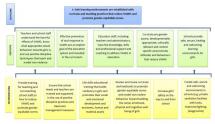Addressing Violence against Women and Girls in Education Programming
This is part two of a guidance tool (part one is here) which focuses specifically on how to address violence against women and girls through education programming.
The tool aims to make progress towards two key impacts:
- Girls and boys gain valuable knowledge, skills and self-confidence through education in gender-responsive environments free from all forms of violence or threat of violence
- Education systems, through formal and informal settings, actively contribute to the development of more gender-equitable societies, where VAWG is not tolerated
This guidance note aims to provide practical advice and tips to support DFID advisors and program managers and other UK government departments to strengthen the impact of education
programs in addressing VAWG.
Part A sets out the strategic rationale and broad approach to addressing VAWG in education programming.
and covers the following:
Part B (this tool) provides specific guidance on designing programs for each key outcome area:
- Outcome-specific challenges
- Developing an engagement strategy–which sets out specific questions to be analysed in order to decide where and how to intervene
- Options for intervention
- Case studies of promising practices and lessons learned
- Mini theories of change for each outcome
- Examples of indicators
Last modified: March 25, 2019

